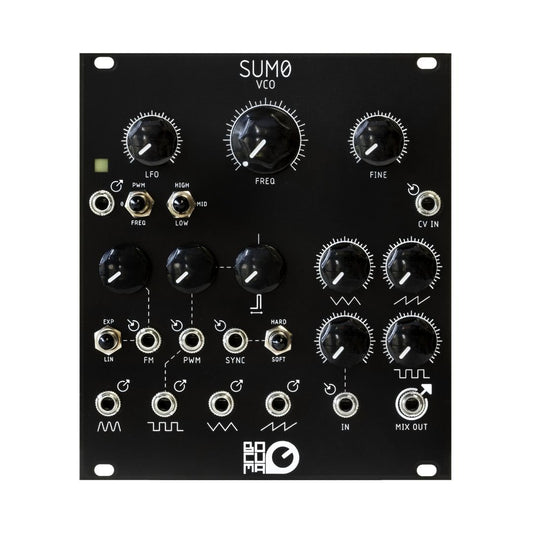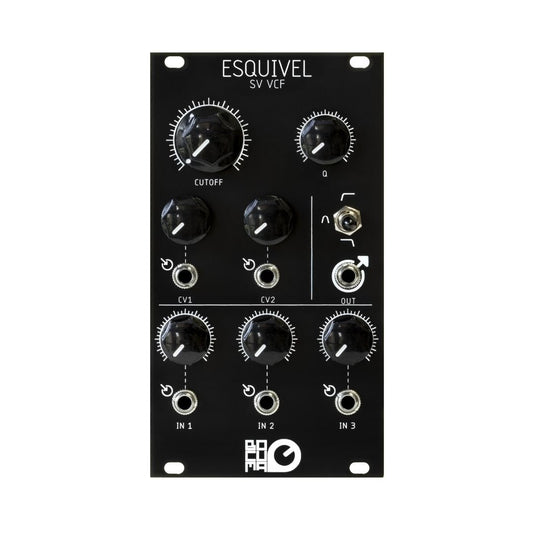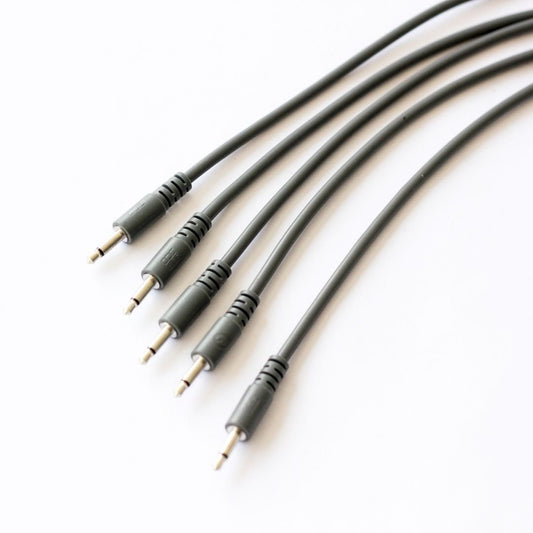All you need to know about modular synths to become a pro in a day.
Welcome to the exciting world of modular synthesis! If you're eager to delve into the depths of electronic sound creation, you've come to the right place. In this chapter, we'll be demystifying two fundamental components of modular synthesizers: Voltage Controlled Oscillators (VCOs) and Voltage Controlled Filters (VCFs).
By the end of this guide, you'll confidently understand what they are, how to use them, and even get hands-on with a couple of noteworthy models: SUM0 VCO and Esquivel VCF.
What is a Modular Synthesizer?
At its core, a modular synthesizer is a unique electronic instrument designed to generate, manipulate, and sculpt sound. What sets modular synths apart is their modular nature – they consist of individual modules that you can arrange, connect, and control to create custom signal paths and unique sonic landscapes. Think of it as building your own sonic playground, where you're the architect of sound.
Modules are the building blocks of a modular synthesizer. Each module serves a specific purpose, whether it's generating sound, shaping it, or adding effects.
Common types of modules include:
- Oscillators (VCOs): These produce audio waveforms, the raw materials of sound. You can think of them as the musical equivalent of a painter's palette, offering various waveforms like sine, sawtooth, square, and more.
- Filters (VCFs): Filters sculpt sound by emphasizing or attenuating certain frequencies. They're like sonic chisels that help you shape the tone and texture of your sounds.
- Envelopes: Envelopes control how a sound evolves over time. They define the attack, decay, sustain, and release of a sound, allowing you to shape everything from sharp plucks to long drones.
- LFOs (Low-Frequency Oscillators): LFOs generate cyclical waveforms at lower frequencies than audio oscillators. They're perfect for creating rhythmic modulation effects like tremolo and vibrato.
- Sequencers: Sequencers help you create patterns of control voltages (CV) that determine how other modules behave. They're fantastic for crafting evolving melodies and rhythms.
- Mixers: Mixers blend signals together. You can mix audio signals or control voltages to create complex modulation sources.
Patch Cables and Signal Flow.
Modular synthesis involves patching cables between modules to define the signal flow. By connecting outputs to inputs, you create pathways for control voltages and audio signals. This patching process allows for endless experimentation and exploration, enabling you to craft sounds that are truly your own.
One of the most exciting aspects of modular synthesizers is their limitless potential for creativity. Unlike traditional synthesizers with fixed signal paths, modular synths empower you to design your own setups and experiment with unconventional connections. This flexibility encourages innovation, letting you discover new sonic territories and push the boundaries of sound design.
Learning modular synthesis is a journey that rewards hands-on exploration. As you experiment with different modules, patch configurations, and modulation sources, you'll develop an intuitive understanding of sound synthesis principles. While it may seem complex at first, take it step by step, and you'll soon find yourself immersed in a world of sonic discovery.
Modular synthesizers offer a playground for sonic adventurers, a realm where creativity knows no bounds. By assembling modules, connecting cables, and exploring the vast universe of sound synthesis, you're embarking on a thrilling journey that promises both artistic expression and technical mastery.
Understanding VCO (Voltage Controlled Oscillator).
At the heart of any synthesizer lies the oscillator, a sound source that generates various waveforms. VCOs take this concept to the next level by introducing voltage control, allowing you to manipulate the frequency of the generated waveform using control voltages. Here's how to use a VCO:
Waveform Selection: Most VCOs offer a variety of waveforms, such as sine, sawtooth, square, and triangle. Experiment with these to explore different timbres and textures.
Frequency Control: The primary function of a VCO is to generate sound at a particular pitch. This is achieved by controlling the frequency, usually in Hertz. Connect a control voltage source (like a keyboard or sequencer) to the VCO's frequency input to determine the pitch.
Modulation: VCOs often have modulation inputs that allow you to create dynamic and evolving sounds. By applying a low-frequency oscillator (LFO) or an envelope generator to the modulation input, you can achieve effects like vibrato and FM synthesis.
Imagine you have a SUM0 Harmonic Summing Vco. With its diverse waveform options and precise tuning capabilities, you can craft everything from soothing pads to aggressive leads.
To start, choose a waveform that suits your desired sound. Next, connect a control voltage source, such as a MIDI controller, to the frequency input. Experiment with different voltages to create melodies at varying pitches. For added depth, try patching an LFO into the modulation input to introduce subtle pitch modulation.
Unveiling VCF (Voltage Controlled Filter).
Once you've generated a sound with the VCO, it's time to shape its character using a Voltage Controlled Filter (VCF). VCFs act as a sculpting tool, allowing you to emphasize or attenuate specific frequencies. Here's how to use a VCF:
Filter Types: VCFs offer various filter types, including low-pass, high-pass, band-pass, and notch filters. Each type emphasizes different frequency ranges. For instance, a low-pass filter allows low frequencies to pass while attenuating higher ones.
Cutoff Frequency: This parameter controls the point at which the filter starts attenuating frequencies. Lower cutoff frequencies result in a muffled sound, while higher cutoffs let more frequencies pass through.
Resonance: Resonance boosts the frequencies around the cutoff point, creating a peak in the frequency response. This can lead to a distinctive and expressive sound character.
Let's explore the capabilities of a VCF module, taking as an example our Esquivel VCF + mixer. Begin by selecting a filter type that complements your sound source. Connect the output of your VCO to the input of the VCF. Adjust the cutoff frequency to sculpt the timbre of your sound.
Experiment with resonance to introduce harmonic emphasis. You can also modulate the cutoff frequency using an envelope generator or an LFO for dynamic filter sweeps.
SUM0 VCO & Esquivel VCF.
Our beloved SUM0 VCO is a versatile module that opens up a world of harmonic exploration. Let's say you're aiming to create a lush pad sound with evolving harmonics. Here's how you can incorporate SUM0 VCO into your setup:
Waveform Selection: Begin by selecting a waveform that suits your pad sound. A sawtooth waveform can provide a rich foundation while adding a touch of pulse wave can introduce interesting textures.
Frequency Modulation: To add movement and depth to your sound, patch an LFO into the frequency modulation input of SUM0 VCO. This will gently modulate the pitch, creating a drifting effect that complements the pad's ambiance.
Waveform Modulation: Experiment with waveform modulation by patching an envelope generator into the waveform input of SUM0 VCO. As the envelope evolves, it will morph the waveform, resulting in evolving harmonics over time.
Mixing and Layering: Connect the output of SUM0 VCO to a mixer or another sound-shaping module. Blend it with other sound sources to create intricate sonic textures. Consider layering it with other oscillators or even samples to expand your pad's sonic palette further.
Our Esquivel VCF is a powerful tool for adding character and movement to your sounds. Let's explore how you can use it to create dynamic filter sweeps for a lead synth:
Lead Sound Generation: Start by creating a lead sound using a suitable VCO. Dial in a waveform that suits your desired lead timbre. A square or sawtooth wave can work well for this purpose.
Filter Connection: Connect the output of your VCO to the input of Esquivel VCF. This will allow the filter to shape the character of your lead sound.
Cutoff Modulation: To introduce dynamic movement, patch an envelope generator's output into the cutoff frequency input of Esquivel VCF. As you play a note, the envelope will control the filter's cutoff frequency, creating expressive filter sweeps that follow your playing dynamics.
Resonance Emphasis: Experiment with the resonance control on the Esquivel VCF. Increasing the resonance can lead to pronounced peaks in the frequency response, adding a touch of expressive emphasis to your lead lines.
Live Performance: As you play your lead melody, you'll notice how the filter responds dynamically to your playing style. You can achieve effects ranging from subtle filter opening and closing to dramatic filter sweeps that add a sense of movement and excitement to your performance.
These examples demonstrate the versatility and creative potential of our SUM0 VCO and Esquivel VCF modules within your modular synthesizer setup. By combining their capabilities with other modules in your collection, you'll unlock a world of sonic possibilities that allow you to sculpt sounds that are truly your own.
Take a look at our website for more information about our products, and we highly recommend you check out our blog too, where we share informational posts like this one, tips, and tricks to help you dominate the world of modular synths.





